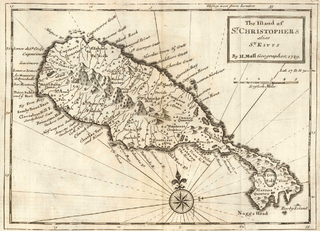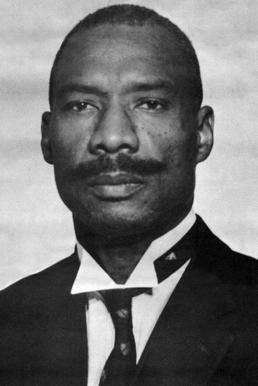
Nevis is an island in the Caribbean Sea that forms part of the inner arc of the Leeward Islands chain of the West Indies. Nevis and the neighbouring island of Saint Kitts constitute the Federation of Saint Kitts and Nevis, a singular nation state. Nevis is located near the northern end of the Lesser Antilles archipelago about 350 kilometres (220 mi) east-southeast of Puerto Rico and 80 kilometres (50 mi) west of Antigua. Its area is 93 square kilometres (36 sq mi) and the capital is Charlestown.

Saint Kitts and Nevis, officially the Federation of Saint Kitts and Nevis, is an island country consisting of the two islands of Saint Kitts and Nevis, both located in the West Indies, in the Leeward Islands chain of the Lesser Antilles. With 261 square kilometres (101 sq mi) of territory, and roughly 50,000 inhabitants, it is the smallest sovereign state in the Western Hemisphere, in both area and population, as well as the world's smallest sovereign federation. The country is a Commonwealth realm, with Charles III as King and head of state.

Saint Kitts and Nevis have one of the longest written histories in the Caribbean, both islands being among Spain's and England's first colonies in the archipelago. Despite being only two miles apart and quite diminutive in size, Saint Kitts and Nevis were widely recognized as being separate entities with distinct identities until they were forcibly united in the late 19th century.

The politics of Saint Kitts and Nevis takes place in the framework of a federal parliamentary democracy. Saint Kitts and Nevis is an independent Commonwealth realm with Charles III as its head of state, viceregally represented by a Governor-General. He acts on the advice of the prime minister, who is the majority party leader in the National Assembly, and who, with a cabinet, conducts affairs of state.

Saint Kitts, officially Saint Christopher, is an island in the West Indies. The west side of the island borders the Caribbean Sea, and the eastern coast faces the Atlantic Ocean. Saint Kitts and the neighbouring island of Nevis constitute one country: the Federation of Saint Kitts and Nevis. Saint Kitts and Nevis are separated by a shallow 3-kilometre (2 mi) channel known as "The Narrows".
The history of Anguilla runs from the beginning of human habitation, probably via settlement from South America, through its colonization by the English in the early modern period, to the present day. Following a series of rebellions and a short-lived period as an independent republic during the 1960s, Anguilla has been a separate British overseas territory since 1980.

Charlestown is the capital of the island of Nevis in the Federation of Saint Kitts and Nevis in the Leeward Islands of the West Indies. Charlestown is situated on the leeward side of the island of Nevis near the southern end of Pinney's Beach.

Robert Llewellyn Bradshaw was the first Premier of Saint Kitts and Nevis, and previously served as Chief Minister, legislator, and labour activist.
Redleg is a term used to refer to poor whites that live or at one time lived on Barbados, St. Vincent, Grenada and a few other Caribbean islands. Their forebears were sent from England, Scotland, Ireland, and Continental Europe as indentured servants, forced labourers, or peons.

Saint Christopher-Nevis-Anguilla was a British colony in the West Indies from 1882 to 1983, consisting of the islands of Anguilla, Nevis, and Saint Christopher. From 1882 to 1951, and again from 1980, the colony was known simply as Saint Christopher and Nevis. Saint Christopher and Nevis gained independence in 1983 as the Federation of Saint Kitts and Nevis, while Anguilla would remain a British overseas territory.

The monarchy of Saint Kitts and Nevis is a system of government in which a hereditary monarch is the sovereign and head of state of Saint Kitts and Nevis. The current monarch of Saint Kitts and Nevis, since 8 September 2022, is King Charles III. As sovereign, he is the personal embodiment of the Crown of Saint Kitts and Nevis. Although the person of the sovereign is equally shared with 14 other independent countries within the Commonwealth of Nations, each country's monarchy is separate and legally distinct. As a result, the current monarch is officially titled King of Saint Christopher and Nevis and, in this capacity, he and other members of the royal family undertake public and private functions domestically and abroad as representatives of Saint Kitts and Nevis. However, the King is the only member of the royal family with any constitutional role.

Frances "Fanny" Nelson, Viscountess Nelson, Duchess of Bronte was the wife of Horatio Nelson, the British naval officer who won several victories over the French during the French Revolutionary and Napoleonic Wars.
Migration from Ireland to Saint Kitts and Nevis in the West Indies began in the 1620s, when the islands of Saint Kitts and Nevis became part of the British Empire, and continued into the 18th century.
Afro-Kittitians and Nevisians are Saint Kitts and Nevis people whose ancestry lies within the continent of Africa, most notably West Africa.

Visitors to Saint Kitts and Nevis must obtain a visa, unless they come from one of the visa exempt countries.

Sir William Stapleton, 1st Baronet was an Irish colonial administrator and planter who served as the governor of the Leeward Islands from 1671 to 1686, when he died in office. Born in Ireland to a family of Norman descent, William, as a Royalist during the Wars of the Three Kingdoms, followed Charles II into exile in France.

The primary law governing Saint Kitts and Nevis nationality regulations is the Saint Christopher and Nevis Citizenship Act, which came into force on 28 February 1984.
William Mathew Burt was a British politician and colonial administrator. He owned properties on Saint Kitts and Nevis and served as governor of the British Leeward Islands from 1776 until his death in 1781. He was also member of parliament for Great Marlow from 1761 to 1768.










